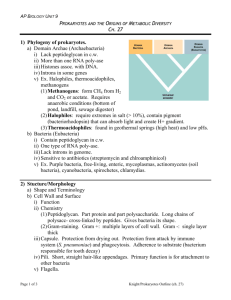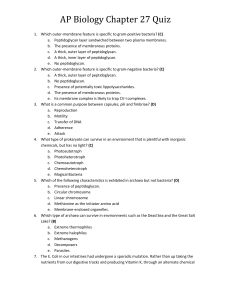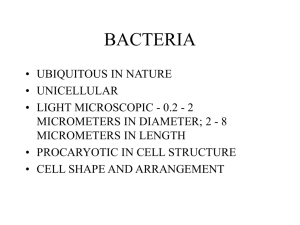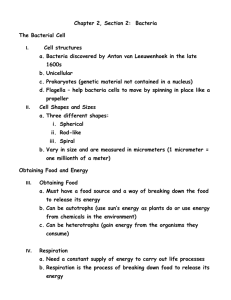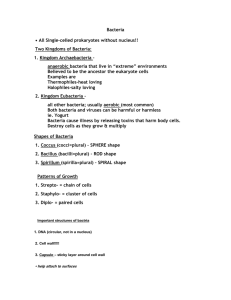OldExam 1
advertisement
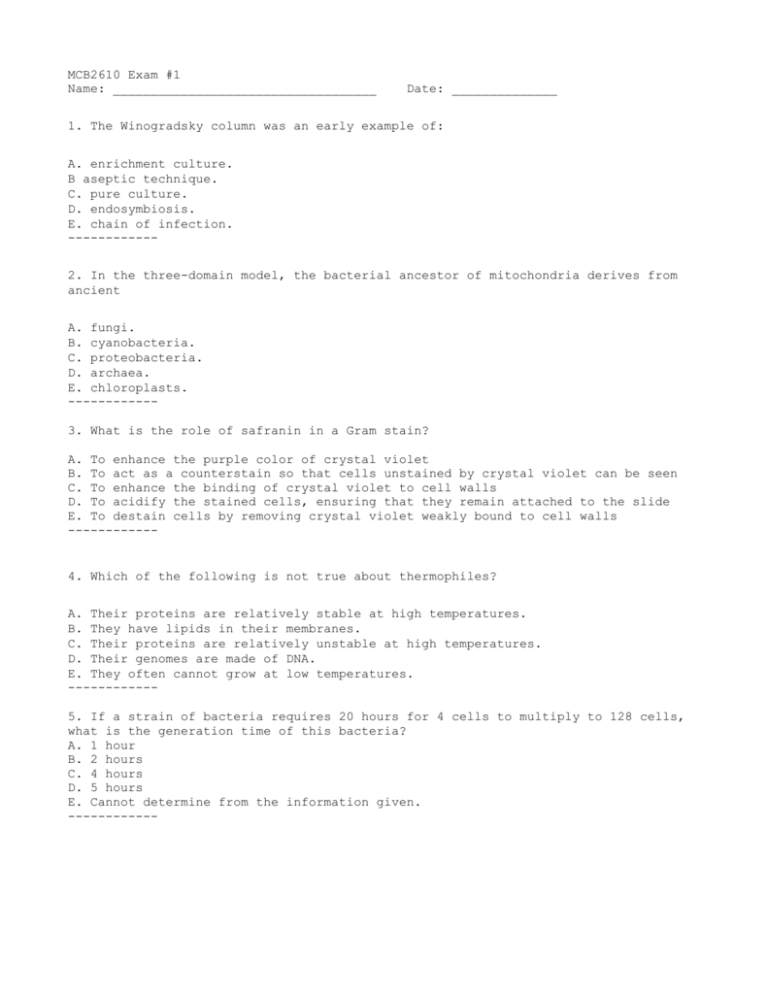
MCB2610 Exam #1 Name: ___________________________________ Date: ______________ 1. The Winogradsky column was an early example of: A. enrichment culture. B aseptic technique. C. pure culture. D. endosymbiosis. E. chain of infection. -----------2. In the three-domain model, the bacterial ancestor of mitochondria derives from ancient A. fungi. B. cyanobacteria. C. proteobacteria. D. archaea. E. chloroplasts. -----------3. What is the role of safranin in a Gram stain? A. To enhance the purple color of crystal violet B. To act as a counterstain so that cells unstained by crystal violet can be seen C. To enhance the binding of crystal violet to cell walls D. To acidify the stained cells, ensuring that they remain attached to the slide E. To destain cells by removing crystal violet weakly bound to cell walls ------------ 4. Which of the following is not true about thermophiles? A. Their proteins are relatively stable at high temperatures. B. They have lipids in their membranes. C. Their proteins are relatively unstable at high temperatures. D. Their genomes are made of DNA. E. They often cannot grow at low temperatures. -----------5. If a strain of bacteria requires 20 hours for 4 cells to multiply to 128 cells, what is the generation time of this bacteria? A. 1 hour B. 2 hours C. 4 hours D. 5 hours E. Cannot determine from the information given. ------------ 6. Imagine that you have discovered a new bacterium that you call Dividium tripartum because it divides into 3 daughter cells instead of 2 like other bacteria. If you inoculated a single cell of Dividium tripartum into some growth medium how many bacteria would be in the flask 15 hours later, if the generation time was 1 hour per generation? A. About 14 billion B. About million C. About 320 thousand D. About 32 thousand E. 45 -----------7. A medium for growth of a bacterium that contains yeast or beef extract is best described as a(n) _______ medium. A. defined B. poor C. complex D. semisynthetic E. enrichment -----------8. FILL IN THE BLANKS: The SOFEx team measured the increase in __________ falling to the ocean bottom, after the addition of ________________ to regions of the southern Pacific. A. carbon, CO2 B. fish, iron C. iron, carbon D. carbon, iron E. nitrogen, carbon -----------9. Penicillin is most effective against A. replicating gram-positive bacteria. B. nonreplicating gram-positive bacteria. C. replicating gram-negative bacteria. D. nonreplicating gram-negative bacteria. E. Both a and b -----------10. In which of the following lists are the objects ordered by increasing size? A. amino acids, typical virus, a protein, typical bacterium, typical plant cell B. a protein, amino acids, typical virus, typical bacterium, typical plant cell C. typical virus, amino acids, a protein, typical bacterium, typical plant cell D. amino acids, a protein, typical virus, typical plant cell, typical bacterium E. amino acids, a protein, typical virus, typical bacterium, typical plant cell -----------11. Which feature of a gram-negative bacterium distinguishes it from a grampositive bacterium? A. The presence of an inner membrane containing superoxide dismutase B. The presence of thin peptidoglycan C. The presence of a cell wall D. The absence of a cell wall E. They are not different structurally. ------------ 12. During a random biased swim toward an area which contains a higher concentration of an repllent molecule bacteria such as E. coli tend to: A. swim more quickly (increase their speed). B. tumble more frequently C. tumble less frequently D. slow down E. synthesize more flagella -----------13. The earliest prokaryotic metabolism is thought to probably have been A. one which did not use O2. B. one which did use O2. C. one in which DNA was missing. D. one in which RNA was missing. E. one in which DNA and RNA were both missing. 14. Which of the following bacterial species form endospores? A. Escherichia coli B. Streptococcus mutans C. Clostridium botulinum D. Vibrio cholera E. Staphylococcus aureus -----------15. Which of the following elements is not a major requirement for the growth of all bacteria? A. carbon B. phosphorus C. boron D. sulfur E. nitrogen -----------16. Below are groups containing several structures. Select the group in which ALL of the structures are found ONLY in Gram- bacteria. A. LPS, thick peptidoglycan, flagella B. Ribosomes, outer membrane channels C. Thin peptidoglycan, endospores D. Flagella, thin peptidoglycan E. LPS, outer membrane channels -----------17. Which of the following statements about fimbrae and flagella are true? A. Fimbrae and flagella can both be used for motility B. Flagella and fimbrae are different terms for the same structures C. Flagella are generally short and fimbrae are generally longer D. There is generally 1-3 fimbrae on the surface of bacterial cells E. Two of the above are true ------------ 18. Many of the stains used in microbiology have charged nitrogen atoms (N+). These impart what characteristic upon the stains? A. They enhance binding to negatively charged cell constituents such as nucleic acids and cell surfaces B. They enhance binding to positively charged cell constituents such as nucleic acids and cell surfaces C. They cause them to be repelled by negatively charged cell constituents such as nucleic acids and cell surfaces D. They are not important for staining reactions E. They prevent the stain from being toxic and killing the cells -----------19. Which of the following is a characteristic of eukaryotes, but not prokaryotes? A. 70S ribosomes B. 80S ribosomes C. peptidoglycan D. A nucleoid E. More than one of the above are correct. -----------20. Which of the following statements is FALSE? A. Some viruses are as B. Many eukaryotes can C. Bacterial cells can D. Most viruses cannot ------------ big as small prokaryotes be seen by the naked eye never be seen by the naked eye be seen by the naked eye 21. Penicillin-type antibiotics work by: A. causing bacterial cells to lyse because their cell membranes become weakened B. inhibiting the addition of peptides to NAM in peptidoglycan synthesis C. acting as a peptide mimic and inhibiting peptidoglycan synthesis D. acting as a NAM mimic and inhibiting peptidoglycan synthesis E. inhibiting the addition of new NAG and NAM molecules to peptidoglycan -----------22. The lipid moieties in Archaea membranes are A. hopanoids. B. sterols. C. isoprenoids. D. glycerol-linked ethers. E. glycerol-linked esters. -----------23. Which of the following scientists is responsible for defining the Archaea as a third domain? A. Carl Woese B. Norm Pace C. James Watson D. Francis Crick E. Rosalind Franklin ------------ 24. Which of the following genera within the spirochetes includes the causative agent of Lyme disease? A. Borrelia B. Holandina C. Leptospira D. Treponema E. Spirochaeta -----------25. Bacterial DNA is contained in a structure called: A. A nuclear reactor B. A nuclear body C. A nucleus D. A nucleoid E. A nucleon ---------26. Prokaryotes that produce flagella from all locations on the cell surface exhibit _______ flagellation. A. monotrichous B. multitrichous C. lophotrichous D. peripheraltrichous E. peritrichous ---------27. The tree of life as shown in lecture has three domains, two contain only prokaryotes. What are the names of these domains? A. Prokaryotes and viruses B. Gram positives and Gram negative C. Proteobacteria and Firmicutes D. Eubacteria and Archaea E. None of the above, because all prokaryotes are in one domain ---------28. The lipid moieties in Archaea membranes are A. hopanoids. B. sterols. C. isoprenoids. D. glycerol-linked ethers. E. glycerol-linked esters. ---------29. What is the main function of the Gram stain? A. To enhance the contrast of bacteria so they can be seen B. To differentiate prokaryotes from eukaryotes C. To differentiate eubacterial cells from archaeal cells D. To stain bacterial endospores E. To differentiate Gram+ from Gram- bacteria ---------30. Anaerobes cannot handle the presence of oxygen. Why is that? A. B. C. D. Oxygen Oxygen Oxygen Oxygen is a requirement for growth these bacteria blocks respiration in these bacteria inhibits key enzymes needed for flagellar motility interferes with for twitching motility E. None of the above are correct 31. Figure 1 on the back page of the exam shows the peptide crosslinking reaction. The crosslinking reaction (the transpeptidation reactions) is: A. B. C. D. E. An An An An An attack attack attack attack attack of of of of of “group “group “group “group “group a” b” e” a” c” on on on on on “group “group “group “group “group f” d” b” d” d” Give at least two specific examples of antibiotics and their targets. You may not list two different beta-lactams. In the space below, draw the cell envelope of a E. coli cell. Include the following items if E. coli has them: the cell membrane, peptioglycan, periplasm, outer membrane, OMPs, lipopolysaccharide. ------------ 33. Name 5 ways in which prokaryotic cells (bacteria) differ from eukaryotic cells. A child student took some garden mud, boiled it and added to an Easy Bake cake mix consisting of sugar, flour, water, dried egg and oil (all sterile) to make mud pie. After letting it cook in the sun for a day, the mixture was nasty stinking mess. If an enterprising MCB2610 student took the mess to lab and cultured the organisms, what would she be most likely to find and why? (2 extra points if you can name the Genus and give the correct reason naming that Genus)

